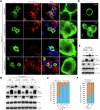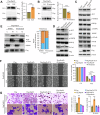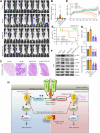Inhibiting S-palmitoylation arrests metastasis by relocating Rap2b from plasma membrane in colorectal cancer
- PMID: 39277583
- PMCID: PMC11401852
- DOI: 10.1038/s41419-024-07061-2
Inhibiting S-palmitoylation arrests metastasis by relocating Rap2b from plasma membrane in colorectal cancer
Abstract
Rap2b, a proto-oncogene upregulated in colorectal cancer (CRC), undergoes protein S-palmitoylation at specific C-terminus sites (C176/C177). These palmitoylation sites are crucial for Rap2b localization on the plasma membrane (PM), as mutation of C176 or C177 results in cytosolic relocation of Rap2b. Our study demonstrates that Rap2b influences cell migration and invasion in CRC cells, independent of proliferation, and this activity relies on its palmitoylation. We identify ABHD17a as the depalmitoylating enzyme for Rap2b, altering PM localization and inhibiting cell migration and invasion. EGFR/PI3K signaling regulates Rap2b palmitoylation, with PI3K phosphorylating ABHD17a to modulate its activity. These findings highlight the potential of targeting Rap2b palmitoylation as an intervention strategy. Blocking the C176/C177 sites using an interacting peptide attenuates Rap2b palmitoylation, disrupting PM localization, and suppressing CRC metastasis. This study offers insights into therapeutic approaches targeting Rap2b palmitoylation for the treatment of metastatic CRC, presenting opportunities to improve patient outcomes.
© 2024. The Author(s).
Conflict of interest statement
JLZ and EYK are listed as inventors on pending patent covering the targeting of C176 and C177 in Rap2b as intervention strategy for treating cancer.
Figures








Similar articles
-
Rap2B drives tumorigenesis and progression of colorectal cancer through intestinal cytoskeleton remodeling.Cell Death Dis. 2025 Apr 13;16(1):290. doi: 10.1038/s41419-025-07627-8. Cell Death Dis. 2025. PMID: 40223002 Free PMC article.
-
MicroRNA-147b Promotes Proliferation and Invasion of Human Colorectal Cancer by Targeting RAS Oncogene Family (RAP2B).Pathobiology. 2019;86(4):173-181. doi: 10.1159/000495253. Epub 2019 May 23. Pathobiology. 2019. PMID: 31121595
-
Targeting of the small GTPase Rap2b, but not Rap1b, to lipid rafts is promoted by palmitoylation at Cys176 and Cys177 and is required for efficient protein activation in human platelets.Cell Signal. 2008 Sep;20(9):1662-70. doi: 10.1016/j.cellsig.2008.05.016. Epub 2008 Jun 7. Cell Signal. 2008. PMID: 18582561
-
Rap2B GTPase: structure, functions, and regulation.Tumour Biol. 2016 Jun;37(6):7085-93. doi: 10.1007/s13277-016-5033-y. Epub 2016 Mar 24. Tumour Biol. 2016. PMID: 27012552 Review.
-
Protein palmitoylation in cancer: molecular functions and therapeutic potential.Mol Oncol. 2023 Jan;17(1):3-26. doi: 10.1002/1878-0261.13308. Epub 2022 Sep 10. Mol Oncol. 2023. PMID: 36018061 Free PMC article. Review.
Cited by
-
Comprehensive analysis of a palmitoylation-related prognostic signature in colorectal cancer: Implications for immune therapy and personalized treatment.Oncol Lett. 2025 May 16;30(1):350. doi: 10.3892/ol.2025.15096. eCollection 2025 Jul. Oncol Lett. 2025. PMID: 40438869 Free PMC article.
-
Rap2B drives tumorigenesis and progression of colorectal cancer through intestinal cytoskeleton remodeling.Cell Death Dis. 2025 Apr 13;16(1):290. doi: 10.1038/s41419-025-07627-8. Cell Death Dis. 2025. PMID: 40223002 Free PMC article.
-
Potential therapeutic target in oncology: Protein palmitoylation (Review).Oncol Rep. 2025 Oct;54(4):117. doi: 10.3892/or.2025.8950. Epub 2025 Jul 19. Oncol Rep. 2025. PMID: 40682839 Free PMC article. Review.
-
Palmitic acid and palmitoylation in cancer: Understanding, insights, and challenges.Innovation (Camb). 2025 Apr 29;6(8):100918. doi: 10.1016/j.xinn.2025.100918. eCollection 2025 Aug 4. Innovation (Camb). 2025. PMID: 40814339 Free PMC article. Review.
References
-
- Canobbio I, Trionfini P, Guidetti GF, Balduini C, Torti M. Targeting of the small GTPase Rap2b, but not Rap1b, to lipid rafts is promoted by palmitoylation at Cys176 and Cys177 and is required for efficient protein activation in human platelets. Cell Signal. 2008;20:1662–70. 10.1016/j.cellsig.2008.05.016 - DOI - PubMed
MeSH terms
Substances
Grants and funding
LinkOut - more resources
Full Text Sources
Medical
Research Materials
Miscellaneous

